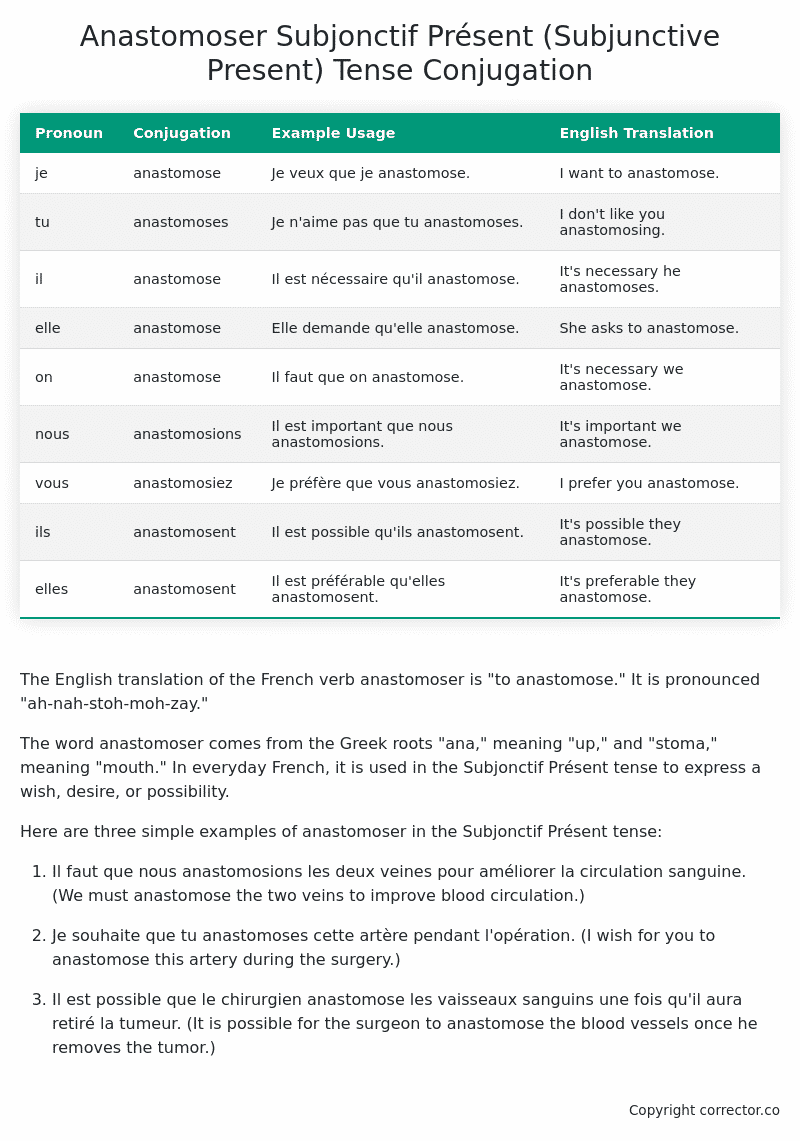Subjonctif Présent (Subjunctive Present) Tense Conjugation of the French Verb anastomoser
Introduction to the verb anastomoser
The English translation of the French verb anastomoser is “to anastomose.” It is pronounced “ah-nah-stoh-moh-zay.”
The word anastomoser comes from the Greek roots “ana,” meaning “up,” and “stoma,” meaning “mouth.” In everyday French, it is used in the Subjonctif Présent tense to express a wish, desire, or possibility.
Here are three simple examples of anastomoser in the Subjonctif Présent tense:
-
Il faut que nous anastomosions les deux veines pour améliorer la circulation sanguine.
(We must anastomose the two veins to improve blood circulation.) -
Je souhaite que tu anastomoses cette artère pendant l’opération.
(I wish for you to anastomose this artery during the surgery.) -
Il est possible que le chirurgien anastomose les vaisseaux sanguins une fois qu’il aura retiré la tumeur.
(It is possible for the surgeon to anastomose the blood vessels once he removes the tumor.)
Table of the Subjonctif Présent (Subjunctive Present) Tense Conjugation of anastomoser
| Pronoun | Conjugation | Example Usage | English Translation |
|---|---|---|---|
| je | anastomose | Je veux que je anastomose. | I want to anastomose. |
| tu | anastomoses | Je n’aime pas que tu anastomoses. | I don’t like you anastomosing. |
| il | anastomose | Il est nécessaire qu’il anastomose. | It’s necessary he anastomoses. |
| elle | anastomose | Elle demande qu’elle anastomose. | She asks to anastomose. |
| on | anastomose | Il faut que on anastomose. | It’s necessary we anastomose. |
| nous | anastomosions | Il est important que nous anastomosions. | It’s important we anastomose. |
| vous | anastomosiez | Je préfère que vous anastomosiez. | I prefer you anastomose. |
| ils | anastomosent | Il est possible qu’ils anastomosent. | It’s possible they anastomose. |
| elles | anastomosent | Il est préférable qu’elles anastomosent. | It’s preferable they anastomose. |
Other Conjugations for Anastomoser.
Le Present (Present Tense) Conjugation of the French Verb anastomoser
Imparfait (Imperfect) Tense Conjugation of the French Verb anastomoser
Passé Simple (Simple Past) Tense Conjugation of the French Verb anastomoser
Passé Composé (Present Perfect) Tense Conjugation of the French Verb anastomoser
Futur Simple (Simple Future) Tense Conjugation of the French Verb anastomoser
Futur Proche (Near Future) Tense Conjugation of the French Verb anastomoser
Plus-que-parfait (Pluperfect) Tense Conjugation of the French Verb anastomoser
Passé Antérieur (Past Anterior) Tense Conjugation of the French Verb anastomoser
Futur Antérieur (Future Anterior) Tense Conjugation of the French Verb anastomoser
Subjonctif Présent (Subjunctive Present) Tense Conjugation of the French Verb anastomoser (this article)
Subjonctif Passé (Subjunctive Past) Tense Conjugation of the French Verb anastomoser
Subjonctif Imparfait (Subjunctive Imperfect) Tense Conjugation of the French Verb anastomoser
Conditionnel Présent (Conditional Present) Tense Conjugation of the French Verb anastomoser
Conditionnel Passé (Conditional Past) Tense Conjugation of the French Verb anastomoser
L’impératif Présent (Imperative Present) Tense Conjugation of the French Verb anastomoser
L’infinitif Présent (Infinitive Present) Tense Conjugation of the French Verb anastomoser
Struggling with French verbs or the language in general? Why not use our free French Grammar Checker – no registration required!
Get a FREE Download Study Sheet of this Conjugation 🔥
Simply right click the image below, click “save image” and get your free reference for the anastomoser Subjonctif Présent tense conjugation!

Anastomoser – About the French Subjonctif Présent (Subjunctive Present) Tense
Formation of the Subjonctif Présent
Common Everyday Usage Patterns
Interactions with Other Tenses
Summary
I hope you enjoyed this article on the verb anastomoser. Still in a learning mood? Check out another TOTALLY random French verb conjugation!


